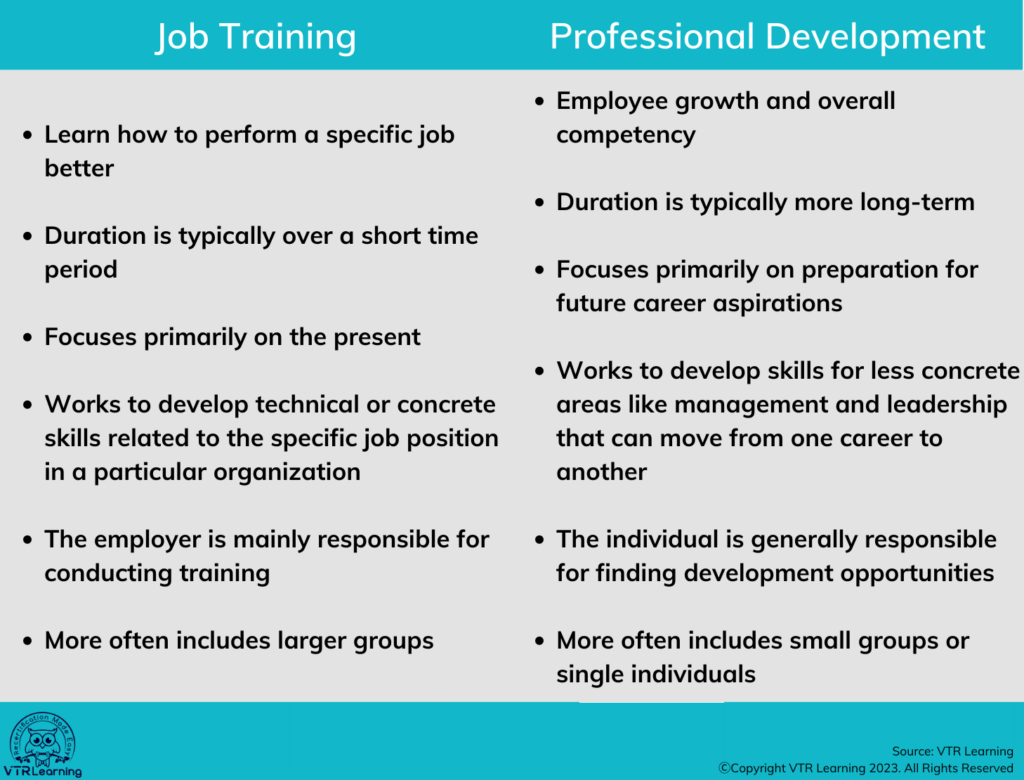![Job Training vs Professional Development [The Differences Explained]](https://assets.vtrlearning.com/wp-uploads/2023/08/Differences-for-Training-vs-Development.png)
Much of the time, we tend to view job training and professional development as synonymous activities. However, despite some subtlety, each stands distinct from the other, and important differences do exist. Generally, job training helps prepare an individual to perform a specific role within a company. But on the other hand, professional development is a more self-guided journey that has a larger impact on full career aspirations. Because the differences in training vs development help inform employee needs, having a basic understanding of the two is important – both for managers and workers.
That’s why we’ve decided to take a look at training vs development to help cement an understanding of what each activity entails. So, if you’re wondering which might benefit you or your employees more, be sure to check out the details below.
Key Differences in Training vs Development
Initially, training and development might seem closely related – and that’s because they are. Each deals specifically with enhancing knowledge in order for a person to perform different tasks and responsibilities better. However, as already noted, training deals more with specific job tasks while development focuses on larger, career oriented skills. There are several other areas of contrast as well, including:
- Purpose
- Duration
- Focus Time Period
- Skill Focus
- Responsible Party
- Group Size
So, while training and development both have to do with continuing education and enhancing skill sets, they differ in many ways.

Understanding Training vs Development
Purpose
Overall, job training refers to different learning activities that help an individual how to perform their specific job at a distinct organization better. For example, if you were hired as an Amazon driver, you would receive instruction on road safety, route planning, and navigation. While job training might occur at different intervals to help update or inform lacking areas, much of it can happen during orientation. So, the overall purpose of job training is to prepare a worker for the specific job they’ll be performing for a company.
Conversely, professional development aims at employee growth and competency in a wide range of areas, not simply skills they need for their current job. For example, an Amazon employee hoping to move up into a management position might seek out leadership training through third-party professional development providers. While the skills they learn might help them in their current role, they aren’t necessarily directed toward that job specifically. That sets development apart from job training, because it focuses more on the individual’s abilities that could pass from one career to the next.
Duration
Typically, job training is a short-term solution to help individuals understand the different aspects of performing their role in a company. And because much of the time, this sort of training is cut-and-dry, black-and-white, it doesn’t take much time. Once an employee learns the ropes, they simply perform their job.
However, professional development is typically an ongoing process. In fact, lifelong learning is the hallmark of this sort of education, because development deals with less concrete skills that can change over time. For instance, best practices for management might look different in twenty years than they do now. So, C-suite executives have to keep up with those skills in order not to fall behind. The duration, then, of development can last a lifetime while job training happens in the short-term.
Focus Time Period
Closely related to duration is the focus time period of training vs development. As might be expected, job training focuses on the present – preparing an employee to perform their job now. Again, this is the purpose of worker orientation. It helps establish the basic principles and guides for how to perform a job to the best of one’s ability.
On the other hand, professional development has a future-focused leaning. It doesn’t neglect the present, per se. However, it seeks to equip individuals with the different skills they’ll need in order to advance their careers when opportunity arises. Think of this as preparation for promotions into higher-paying positions of leadership and responsibility. So, while job training prepares for an existing reality, professional development equips for future aspirations.
Skill Focus
Ultimately, job training focuses in on technical and concrete skills workers need in order to perform their jobs correctly. For example, a graphic designer needs to know how to use different tools like Canva or Photoshop to create eye-catching images. Because these tools have specific uses and very established methods, instruction on how to use them appropriately would likely be part of job training.
Professional development instead focuses on less concrete skills that fall more within the managerial realm. As noted previously, these professional skills might fall within areas such as leadership, communication, or problem solving. They’re abilities that don’t always have correct or incorrect methods of performance but are up to individual interpretation. In other words, they lack the black-and-white shades of job training.
Responsible Party
When it comes to job training, the party responsible for setting it up and providing it is the company at large. After all, they want their workers to perform tasks in-line with corporate guidelines and policies. So, they have the responsibility for ensuring each individual receives proper instruction on how to do so.
Alternatively, the individual is often most responsible for professional development. They have to take the initiative to seek out different opportunities and activities that will enhance their skills, then complete them without corporate oversight.
Of course, there might be occasional times where the responsible parties mix up somewhat. For example, if a company wants their workers to receive leadership training, that could blur the lines. But generally speaking, organizations stand responsible for job training and individuals for professional development.
Group Size
The size of the group is another area that can sometimes overlap with training vs development. However, it is normal for job training to have larger groups while professional development revolves around smaller crowds. That’s often because job training applies not only to the specific individual but to every person working under the banner of that company. Each person must follow corporate guidelines and pay attention to instructions, otherwise product or service quality could suffer.
Professional development, though, doesn’t fall under company scrutiny in the same way. So, it’s typical for such activities to keep group sizes smaller or even solitary. That is, where an individual completes the training alone. A great example of this might be online, self-paced courses. Because rather than undergoing training with a larger group, an individual completes the activity on their own time.
Knowing Where to Find Professional Development
Of course, as noted, job training is the responsibility of the organization. So, most individuals won’t need to look past their direct managers to find it. Professional development opportunities, though, can be somewhat more difficult to come across, even though there are many providers.
Finding the right fit for your needs isn’t always easy, especially when trying to determine which development to go with. Fortunately, VTR Learning can help. We offer a host of online professional development courses ranging from topics in Medicare to Leadership and Management. So, if you’re hoping to boost your capabilities and advance in your career, check out our courses today.
Last Updated:





